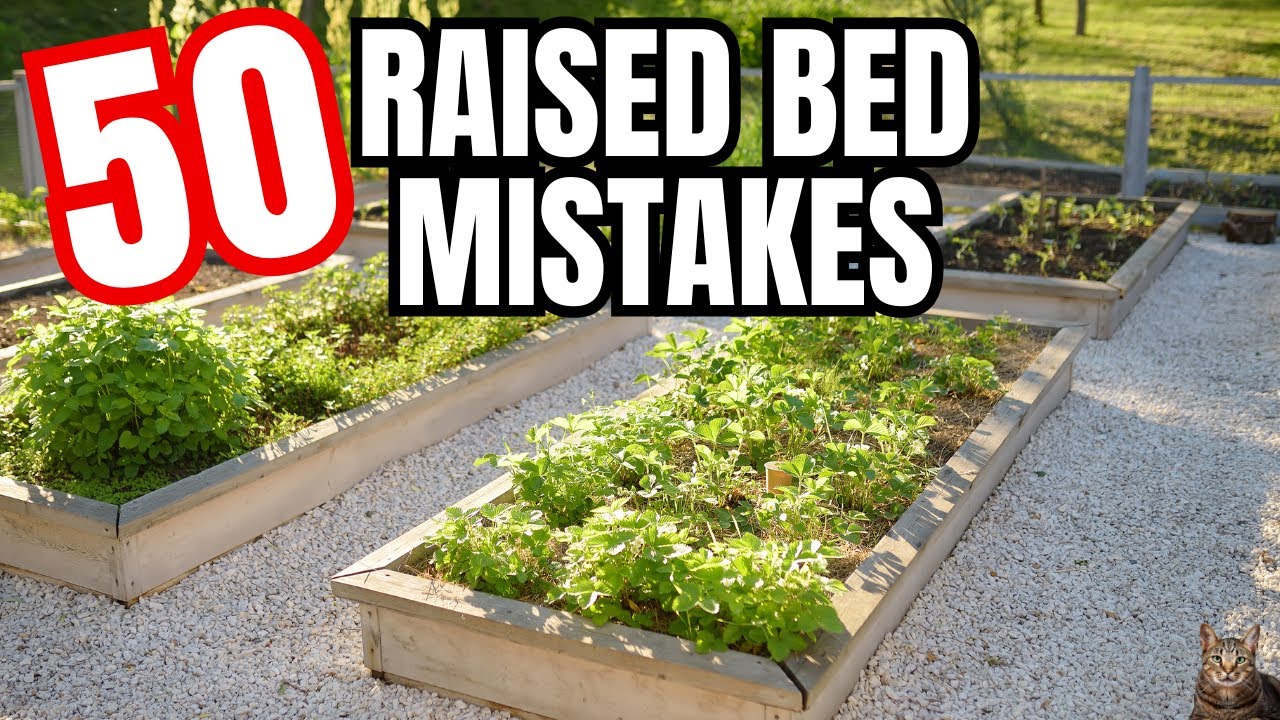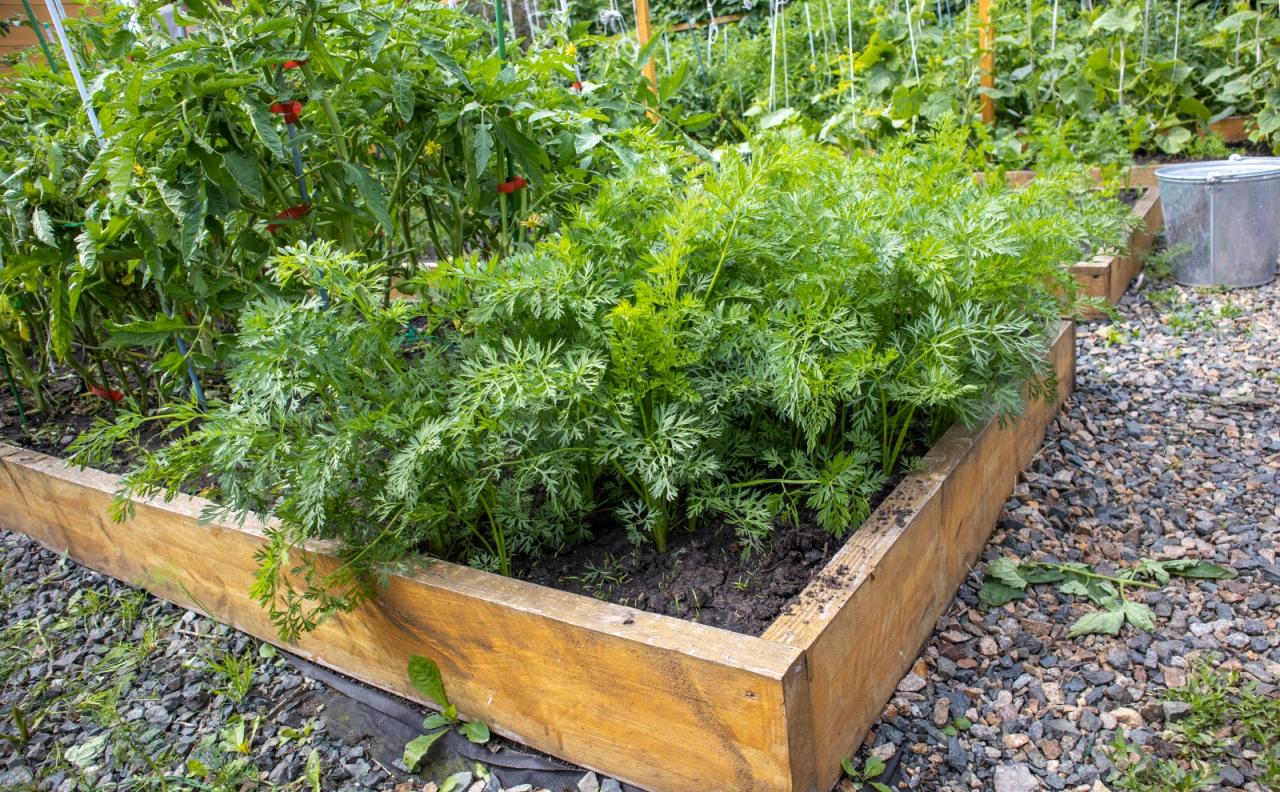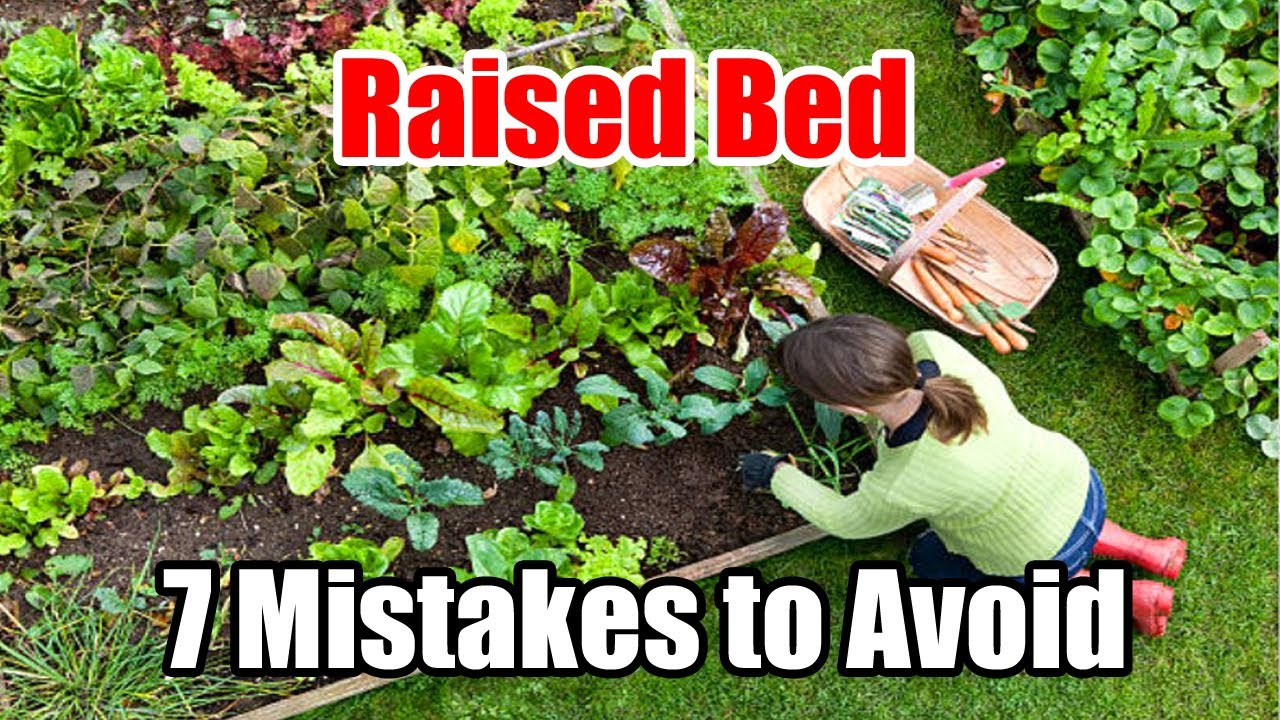Common Planting Mistakes in Raised Beds: Avoiding the Pitfalls – Raised beds offer a fantastic way to grow your own food, but even experienced gardeners can make mistakes. From choosing the wrong location to neglecting proper watering techniques, these errors can significantly impact your plants’ health and yield.
This guide will delve into the most common planting mistakes in raised beds and provide actionable tips to help you avoid them, ensuring a bountiful harvest.
Raised beds provide a controlled environment for growing plants, allowing you to customize the soil and manage pests more effectively. However, without proper planning and execution, even the most well-intentioned gardener can encounter challenges. This article will explore the crucial aspects of raised bed gardening, from choosing the right location and preparing the soil to understanding watering techniques and pest control.
By addressing these common mistakes, you can cultivate a thriving garden and enjoy the fruits (and vegetables) of your labor.
Choosing the Right Location
The success of your raised beds depends heavily on their placement. Selecting the right location ensures your plants receive the necessary sunlight, protection from harsh winds, and adequate drainage, promoting healthy growth.
Sunlight Requirements
Different plants have varying sunlight needs. Some thrive in full sun, requiring at least six hours of direct sunlight daily, while others prefer partial shade, needing only a few hours of direct sunlight and some filtered shade. Understanding the specific sunlight needs of your chosen plants is crucial for their optimal growth.
For instance, tomatoes, peppers, and cucumbers are sun-loving plants that need full sun exposure, while leafy greens like lettuce and spinach prefer partial shade.
Wind Exposure
Strong winds can damage plants, especially delicate seedlings and young plants. Wind can also dry out the soil quickly, leading to dehydration. Selecting a location that offers some protection from prevailing winds is essential. Planting a windbreak of trees or shrubs around your raised beds can help mitigate wind damage.
One common mistake in raised bed gardening is overwatering, which can lead to soggy soil and attract pests. These pesky insects, like fungus gnats, can be particularly troublesome for cacti, as they are drawn to the moist soil. If you’re struggling with a gnat infestation in your cactus plants, check out this helpful guide on How to Get Rid of Gnats in Cactus Plants.
Once you’ve tackled the gnat problem, you can focus on creating a well-draining soil mix for your raised beds to prevent future infestations.
Drainage
Good drainage is crucial for healthy plant growth. Raised beds provide better drainage than traditional in-ground gardens, but it’s still essential to ensure the soil doesn’t become waterlogged. The soil should be able to drain excess water quickly to prevent root rot.
If your location has poor drainage, consider raising the beds higher or incorporating drainage materials like gravel or crushed stone into the base of the bed.
Soil Preparation
Creating a well-draining soil mix is crucial for healthy plant growth in raised beds. This ensures adequate aeration, drainage, and nutrient retention.
Creating a Well-Draining Soil Mix
A well-draining soil mix is essential for raised beds as it prevents root rot and ensures proper aeration and drainage.
- Start with a base of quality potting mix.This provides a foundation with good structure and nutrient content.
- Incorporate amendments like compost, peat moss, or coco coir.These materials improve drainage, aeration, and water retention.
- Add a small amount of sand or perlite for added drainage.This helps prevent waterlogging and improves aeration.
- Mix the ingredients thoroughly.This ensures a consistent soil mix with the desired properties.
Benefits of Compost and Other Amendments
Compost and other amendments play a vital role in creating a healthy and productive soil mix.
- Compostimproves soil structure, water retention, and nutrient content. It also provides beneficial microorganisms that enhance soil health.
- Peat mossincreases water retention and aeration, making it suitable for plants that prefer slightly acidic conditions.
- Coco coiris a sustainable alternative to peat moss, providing good water retention and aeration.
- Vermicastis a natural fertilizer derived from worm castings, rich in nutrients and beneficial microorganisms.
Soil Testing and Adjusting pH Levels
Soil testing helps determine the pH level and nutrient content of the soil.
One common mistake in raised bed gardening is overcrowding plants, leading to competition for resources and reduced growth. To showcase your thriving plants, consider adding a touch of rustic charm with a DIY macramé plant hanger, How to Make a DIY Macramé Plant Hanger , which will elevate your plants and add a unique aesthetic to your garden.
By properly spacing plants in your raised beds, you’ll ensure optimal growth and create a visually pleasing display that complements your handcrafted macramé hangers.
- Soil pHaffects nutrient availability. Most plants prefer a slightly acidic to neutral pH range (6.0-7.0).
- Soil testscan be purchased online or at garden centers. Follow the instructions carefully to obtain accurate results.
- Adjusting pH levelscan be done using lime (to increase pH) or sulfur (to decrease pH). Apply the appropriate amendments based on the test results.
Planting Depth and Spacing
Planting depth and spacing are crucial factors in the success of your raised bed garden. They directly impact the growth and health of your plants, ensuring they receive adequate sunlight, nutrients, and water.
Determining the Correct Planting Depth
The planting depth for each plant species varies depending on its size and growth habits. Generally, seeds should be planted at a depth that is about two to three times the diameter of the seed. For example, small seeds like lettuce and carrots should be planted very shallowly, while larger seeds like beans and corn require a deeper planting depth.
Here are some general guidelines for planting depth:
- Small seeds:1/4 to 1/2 inch deep
- Medium seeds:1/2 to 1 inch deep
- Large seeds:1 to 2 inches deep
It is essential to check the seed packet for specific planting depth recommendations for each plant variety.
Spacing Plants Appropriately
Spacing plants correctly is crucial for optimal growth and development. When plants are overcrowded, they compete for sunlight, water, and nutrients, leading to stunted growth and reduced yields. Here are some factors to consider when determining spacing:
- Plant size:Larger plants require more space than smaller plants.
- Root system:Plants with deep root systems need more space to spread out.
- Growth habit:Vining or sprawling plants require more space to grow horizontally.
It is essential to research the spacing requirements for each plant species.
Thinning Seedlings
Thinning seedlings is a crucial step in ensuring that plants have enough space to grow. When seeds are sown too densely, they can become overcrowded and compete for resources. Thinning involves removing excess seedlings to create space for the remaining plants.
This is usually done when seedlings have developed their first true leaves.
- How to Thin Seedlings:Gently pull or snip out the weaker seedlings, leaving the strongest ones to grow.
- When to Thin:Thinning should be done when seedlings are still small, as this minimizes stress on the remaining plants.
- Importance of Thinning:Thinning allows plants to develop strong root systems and healthy foliage, resulting in a higher yield.
Thinning may seem like a tedious task, but it is a necessary step in ensuring the success of your raised bed garden.
Watering Techniques
Watering is a crucial aspect of maintaining a thriving raised bed garden. It’s essential to provide the right amount of water to your plants, ensuring they get the moisture they need without becoming waterlogged.
Consistent Watering, Common Planting Mistakes in Raised Beds
Consistent watering is vital for healthy plant growth. Plants need a regular supply of water to access essential nutrients from the soil. The frequency of watering depends on factors like climate, soil type, and plant species. However, it’s generally best to water deeply but less frequently, allowing the soil to dry slightly between waterings.
This encourages deeper root growth and helps prevent overwatering.
Overwatering
Overwatering can be detrimental to your plants. When the soil is constantly saturated, it can lead to root rot, a condition where roots lack oxygen and begin to decay. Signs of overwatering include wilting leaves, yellowing foliage, and a musty smell emanating from the soil.
If you suspect overwatering, it’s essential to reduce watering frequency and allow the soil to dry out somewhat.
Watering Methods
- Watering Can: A simple and effective method for watering small raised beds. Use a watering can with a rose attachment to distribute water evenly and avoid damaging delicate plants.
- Drip Irrigation: A more efficient method that delivers water directly to the root zone of plants. Drip irrigation systems use a network of tubing and emitters to release water slowly and precisely, reducing water waste and minimizing soil erosion.
- Soaker Hoses: Similar to drip irrigation, soaker hoses deliver water slowly and evenly over a larger area. They are ideal for raised beds with a variety of plants and can be easily moved around as needed.
Mulching
Mulch plays a vital role in moisture retention and weed suppression. It acts as a protective layer over the soil, slowing down evaporation and keeping the soil cool and moist. Common mulch materials include wood chips, straw, shredded bark, and compost.
A layer of mulch around your plants can significantly reduce the need for frequent watering and help create a healthier garden environment.
Pest and Disease Control

Raised beds, while offering numerous advantages for gardening, can also attract pests and diseases. Understanding common threats and implementing preventative measures can significantly reduce the risk of infestations and promote healthy plant growth.
Common Pests and Diseases
A variety of pests and diseases can affect plants in raised beds. Identifying these threats early allows for timely intervention and prevents widespread damage.
- Insects:Aphids, whiteflies, spider mites, and beetles are common insect pests that can damage plants by sucking sap, chewing leaves, or transmitting diseases.
- Diseases:Fungal diseases such as powdery mildew, blight, and root rot can cause leaf discoloration, wilting, and plant death.
- Other Pests:Slugs, snails, and rodents can also pose a threat to raised bed gardens, causing damage to plants by feeding on leaves and stems.
Preventative Measures
Proactive measures are essential to minimize the risk of pest and disease infestations. These practices create an unfavorable environment for pests and promote plant health.
- Choose Resistant Varieties:Selecting plant varieties known for their resistance to common pests and diseases reduces the likelihood of infestations.
- Maintain Good Hygiene:Regularly removing weeds, diseased plants, and debris from the garden area reduces the presence of potential pest and disease sources.
- Proper Watering:Overwatering can create conditions favorable for fungal diseases. Ensure adequate drainage and water only when necessary.
- Rotation:Rotating crops annually helps break the life cycles of pests and diseases, preventing their buildup in the soil.
- Companion Planting:Planting certain species together can deter pests and attract beneficial insects. For example, planting basil near tomatoes can help repel whiteflies.
Natural Pest Control Methods
Utilizing natural pest control methods can effectively manage infestations without relying on harmful chemicals.
- Beneficial Insects:Introducing beneficial insects such as ladybugs, lacewings, and parasitic wasps can help control pest populations naturally.
- Diatomaceous Earth:This naturally occurring powder is abrasive to insects, causing them to dehydrate and die.
- Neem Oil:Neem oil is a natural insecticide and fungicide that can effectively control a wide range of pests and diseases.
- Insecticidal Soap:This soap-based solution disrupts the cell membranes of insects, leading to their death.
- Homemade Sprays:Simple mixtures like garlic spray, pepper spray, and baking soda solutions can deter pests and help control fungal diseases.
Fertilizing and Nutrition

Providing adequate nutrients is crucial for healthy plant growth in raised beds. While the initial soil mix might contain sufficient nutrients, these will eventually deplete over time. Fertilizing regularly ensures that your plants have access to the essential elements they need to thrive.
Choosing the Right Fertilizer
Selecting the appropriate fertilizer depends on the specific needs of your plants. Different plants require varying amounts of nitrogen, phosphorus, and potassium, the three primary macronutrients.
- Nitrogenpromotes leafy growth.
- Phosphorussupports root development and flowering.
- Potassiumcontributes to overall plant health and disease resistance.
You can choose from various fertilizer types, each with its pros and cons:
- Granular fertilizersare easy to apply and release nutrients gradually over time.
- Liquid fertilizersoffer quick absorption and are ideal for fast-growing plants or those experiencing nutrient deficiencies.
- Organic fertilizers, such as compost, manure, and bone meal, provide slow-release nutrients and improve soil structure.
Consider using a soil test to determine the specific nutrient levels in your raised bed and guide your fertilizer choices.
Applying Fertilizer Correctly
Over-fertilizing can harm your plants, leading to nutrient imbalances and potential damage. It’s crucial to apply fertilizer correctly to ensure optimal results.
- Follow the package directions: Each fertilizer has specific application rates based on plant type and growth stage. Adhering to these guidelines helps avoid over-fertilization.
- Apply fertilizer evenly: Spread granular fertilizers evenly around the base of plants, avoiding direct contact with stems and leaves. For liquid fertilizers, dilute them according to the instructions and apply with a watering can or hose-end sprayer.
- Water after application: Water the soil thoroughly after applying fertilizer to help the nutrients dissolve and reach the roots. This also prevents fertilizer burn, which can occur when dry fertilizer granules come into direct contact with plant roots.
- Avoid over-fertilizing: Too much fertilizer can lead to excessive leaf growth, reduced flowering, and even plant death. It’s better to under-fertilize than over-fertilize, as plants can always be given additional nutrients later.
Winterizing Raised Beds
Winterizing raised beds is crucial for maintaining their health and ensuring successful gardening in the following season. This process involves preparing the beds for the harsh winter conditions and protecting plants from frost damage. Proper winterization helps prevent soil erosion, nutrient depletion, and damage to plants.
Protecting Plants from Frost Damage
Frost can severely damage or kill plants, especially tender varieties. To protect plants, several methods can be employed:
- Mulching:Applying a thick layer of organic mulch, such as straw, wood chips, or shredded leaves, over the soil surface helps insulate the roots and prevent frost penetration. This layer acts as a buffer, moderating soil temperature and protecting plants from freezing.
- Row Covers:Lightweight fabric covers, known as row covers, can be draped over plants to create a microclimate that protects them from frost. These covers allow sunlight and air to pass through while trapping heat and preventing cold air from reaching the plants.
- Cold Frames:Cold frames are mini-greenhouses that provide a protected environment for plants during the winter months. They consist of a frame covered with glass or clear plastic, allowing sunlight to penetrate while trapping heat inside.
Ending Remarks: Common Planting Mistakes In Raised Beds

By avoiding common planting mistakes in raised beds, you can create a thriving garden that yields bountiful harvests. Remember, careful planning, proper soil preparation, and consistent care are key to success. With the right knowledge and a little effort, you can enjoy the satisfaction of growing your own fresh produce and savor the fruits of your labor.
Question & Answer Hub
What are the benefits of using raised beds?
Raised beds offer several advantages, including improved drainage, better soil quality, and easier access for weeding and harvesting. They also allow you to grow plants in areas with poor soil conditions and create a more controlled growing environment.
How deep should my raised beds be?
The ideal depth for raised beds depends on the type of plants you are growing. For most vegetables and herbs, a depth of 12-18 inches is sufficient. However, some plants, like root vegetables, may require deeper beds.
What is the best material for building raised beds?
There are many materials suitable for building raised beds, including wood, stone, brick, and even recycled materials like pallets. The best choice depends on your budget, aesthetic preferences, and the climate in your area.
How often should I fertilize my raised beds?
The frequency of fertilization depends on the type of plants you are growing and the nutrient content of your soil. As a general rule, you should fertilize your raised beds every 4-6 weeks during the growing season.
